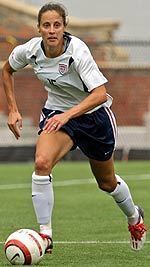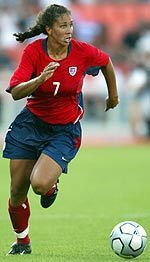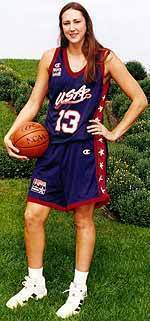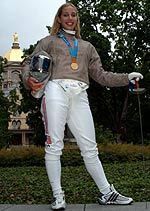Nov. 12, 2004
By Pete LaFleur
If you detect an extra glow of gold as you stroll the Notre Dame campus this weekend, it’s not due to a fresh coat of 24-karat leaf atop the domed administration building. And it’s not because of an increase in the number of golden helmets bobbing up and down on the Irish sideline. But make no mistake about it, there certainly has been a spike in the “gold index” on campus this week – due to the presence of four elite Olympic champions with ties to Notre Dame.
This weekend’s on-field ceremonies will include recognition of the 10 competitors in the 2004 Olympics who have connections to Notre Dame. Three of those individuals – soccer standouts Kate Sobrero and Shannon Boxx and basketball star Ruth Riley – are former Notre Dame student-athletes while a fourth gold medalist, sabre fencer Mariel Zagunis, just began her freshman year under the Golden Dome. All 10 also will receive the honor of Sagamore of the Wabash from the Council of the Sagamores of the Wabash from the office of the Governor of Indiana.
The four “Golden Girls” naturally have their respective compelling story lines that led to Olympic glory. In fact, Sobrero and Riley have followed similar patterns by playing for championship teams at several levels while Boxx and Zagunis both overcame previous disappointments before rising to the top of the medal stand.
Prior to the 2004 Games in Athens, just two Olympic gold medalists had owned ties to Notre Dame: basketball players Vince Boryla (1948, in London) and Adrian Dantley (1976, in Montreal), with Boryla having transferred to the University of Denver. But in one 11-day stretch last August, the aforementioned quartet produced plenty of smiles, cheers and appreciation among the Notre Dame faithful after reaching the Olympic summit. No previous Olympiad had featured more than two medalists (of any kind) with connections to Notre Dame and it had been 28 years since more than one had medaled (two in ’76, also ’32 and ’48).
Sobrero (then a senior), Boxx (a junior) and Riley (a freshman) all were on the Notre Dame campus during the 1997-98 academic year, crisscrossing paths as busy student-athletes with no idea that they one day would be linked as gold medalists at the same Olympiad.
That ’97-’98 school year came on the heels of Notre Dame’s breakthrough appearance in the 1997 NCAA women’s basketball Final Four. A few months later in the fall of ’97, the Irish women’s soccer team fashioned a season that remains one of the most dominant in NCAA history – with a 135-9 scoring edge for a team that was on a collision course to face top-ranked North Carolina in the title game (a 2-1 loss to UConn ended ND’s 23-1-1 season in the semifinals).

Recognized as one of the premier defensive players in the world, Kate Sobrero played every minute for the United States gold medal soccer team at the 2004 Summer Olympics. She was also a member of the 2000 team that won the silver medal.
|
Sobrero – who recently started going by her married name of Markgraf – played on a 1997 back line alongside standout Kelly Lindsey and four-year All-American Jen Grubb (with future national teamer LaKeysia Beene in the goal) while Boxx was part of a ’97 midfield unit that included two other eventual four-year All-Americans in Holly Manthei and Anne Makinen. Seven years later, Sobrero and Boxx were back on the same team as part of the historic gold-medal squad.
A six-year starter with Team USA (at outside and central back), Sobrero previously was a member of the 1999 World Cup championship team and the 2000 Olympic silver medalists. The Bloomfield Hills, Mich., native helped Detroit Country Day High School win a state championship, played alongside Boxx on the 1995 NCAA championship team and went on to be a three-time All-American with the Irish. She is one of just six women’s soccer players ever to win championships at the NCAA, World Cup and Olympic levels, joining former UNC greats Mia Hamm, Christine Lilly, Tisha Venturini, Carla Overbeck and Tisha Venturini in that distinction. Sobrero and Lilly are the only two who also played on high school state-championship teams while Hamm and Venturini won titles during the three-year history of the Women’s United Soccer Association (WUSA).
The 27 all-time Olympians with Notre Dame ties include just two – Sobrero and middle-distance runner Alex Wilson (1,600-meter bronze in ’28; 800-meter silver and 400-meter bronze in ’32) – who have won multiple Olympic medals.
Sobrero was the most consistent member of the U.S. defense that allowed just four goals in six games at the ’04 Olympics, including 30 minutes of tense overtime in each of the final two games (capped by the 2-1 win over Brazil). She logged all 600 minutes in the Olympic matchups and pushed her career “cap” total (games played) to 128, bested by just five of her U.S. teammates.
The five players with more caps are the veteran leaders of the U.S. program – Hamm, Lilly, Julie Foudy, Joy Fawcett and Brandi Chastain – who each likely appeared in their final major international tournament.
“If we had lost, I couldn’t look those five in the eyes,” says Sobrero. “The captains were thanking us in the locker room afterward and I thought it was us who should be thanking them for all that they’ve given over the last 17 years.
“They talked about how the leadership is being handed over to the younger players and that it was in good hands.”
Chastain recently was at Notre Dame’s Alumni Field to support her alma mater Santa Clara in its game versus the Irish and she spoke highly of Sobrero’s value to the national team.
“I’ve always felt that Kate is one of the premier defenders in the world and there’s not a player out there who can beat her on a regular basis,” says Chastain. “It’s a lot of things in combination – hard work, dedication, heart and technique. It’s about attention to detail and she just doesn’t want anyone to get behind her. She has been a continual source of consistency and always is of the highest quality.”
Sobrero essentially is one of the primary “bridge” players between the outgoing legends and the future leaders of the U.S. National Team. And she foresees her former Notre Dame teammate being a key member of the American squad for many years to come.
“Shannon Boxx’s story is so inspiring and she has made such a big impact in a short time,” says Sobrero, who combined with Boxx in making Notre Dame one of two programs (UNC is the other) with multiple alums who were starters on the Olympic team.
“I have the utmost respect for the way that Shannon plays the game and I think she and Abby Wambach are the future leaders of the national team.”
A popular anecdote about Boxx’s stunning emergence took place in the summer of 2003. She had just completed an impressive season as a WUSA all-star with the New York Power and was set to shift her focus to off-the-field concerns. She was going to be an assistant coach at Cal State Dominguez Hills while taking graduate coursework in clinical psychology at Pepperdine and spending time with her fiancée Sean Takata (the couple now is set to be married next April). She also had every intention of attending the 2003 Women’s World Cup … as a spectator.

Shannon Boxx has been labeled as the world’s best defensive midfielder in the women’s game today due to her hard-nosed style and tremendous ball winning skills.
|
Boxx never had merited serious consideration for the national team but she was pleasantly surprised with an invitation to attend the final training camp prior to the 2003 World Cup. That fateful day may have provided Boxx’s final shot at an extended career in the upper echelon of women’s soccer. Non-sports alternatives were waiting on the horizon and the WUSA was set to fold, removing the opportunities to prove herself on that stage.
It was “now or (possibly) never” for Boxx at the August ’03 training camp and the native of Redondo Beach, Calif., blasted through the door of opportunity in unprecedented fashion. Not only was she named to the World Cup roster, Boxx was inserted into the starting lineup and responded by scoring goals in both tuneup games and again in the World Cup opener, becoming the first ever to score in her first three games with the national team.
“Shannon’s story is about perseverance and doing the most when given an opportunity,” says Chastain. “Shannon never complained about not being out there and I think she was ready to move on in her life. In our system she is allowed to be a player who clogs up the middle with good tackles, wins air balls and sets up counterattacks. She is really the only one to `blame’ for her success.”
Boxx earned a spot on the prestigious 11-player all-World Cup team and later was named the captain of an elite FIFA Women’s World Stars Team that defeated Germany (the ’03 World Cup champs) at FIFA’s 2004 Centennial Celebration. That event was held in Paris and Takata was able to attend, providing the future newlyweds with a memorable trip to the romance capital of the world.
“I’m a prime example of the benefits from playing in the WUSA and now I just want to keep playing at this level for as long as I can,” says Boxx, who still owns the Notre Dame record for career games played (101).
Boxx’s first 12 months as a member of the National Team fittingly concluded with her standing alongside Sobrero on the medal stand, with gold medals on their hearts and tears in their eyes.
Former standout Michelle Akers had been the only player ever to score in her first two games with the national team, so perhaps it’s fitting that the player who surpassed that accomplishment now draws comparisons to the former U.S. captain. In fact, few in the international soccer community would argue with the majority who have labeled Boxx as the world’s best defensive midfielder in the women’s game today, a testament to her hard-nosed style and tremendous ball-winning skills.
“That’s a compliment she deserves,” says Chastain, without hesitation. “The women’s game is evolving and there aren’t too many players like Shannon Boxx out there. Perhaps she is redefining that position for the women’s game. She’s becoming a better all-around player and that position allows her to use her strengths.”
Boxx – the first “uncapped” player ever selected to the U.S. World Cup team – actually is not the first Olympic medalist in her family, as her sister Gillian was a catcher with the U.S. softball team that won the gold in 1996.
Notre Dame joined Virginia as the only schools that had an alum on both the U.S. women’s soccer and women’s basketball Olympic teams. Riley is the most recognizable of the gold medalists for Notre Dame fans, due to her recent stardom as the leader of the 2001 NCAA championship team.
The elements of Riley’s Olympic story are similar to both of the former Irish soccer stars. Like Sobrero, Riley has the rare distinction of winning championships at multiple levels – as one of six players ever to win an NCAA, WNBA and Olympic championship, joining Sheryl Swoopes, Swin Cash, Cynthia Cooper, Kara Wolters and Sue Bird in that elite group. And like Boxx (and Zagunis, for that matter), she almost was left out of the Olympic experience.
Riley was not select for the initial 12-player Olympic roster, upsetting her WNBA coach and former Notre Dame player Bill Laimbeer. But Laimbeer and Riley’s countless other fans – stretching from Notre Dame to the Detroit Shock to her hometown of Macy, Ind. – ultimately had the chance to see their favorite player win the gold, as Riley was added to the team as an injury replacement for DeLisha Milton-Jones.
“Playing in the Olympics was the most long-term goal I ever had. I always watched the Olympics as a kid. There was no WNBA then and I had not given much thought to college at that time, so the Olympics was a big dream and goal of mine,” says Riley.

Ruth Riley (second from right) received her gold medal along with her U.S. teammates on her 25th birthday after defeating Australia in the gold-medal game 73-63.
|
“A lot of athletes go through their careers without winning a championship even once, so to be one of the few players to achieve championship success on each of these levels shows how truly blessed I’ve been in my life. It’s a tribute to the hard work I’ve put in and the support and devotion of all the people who have helped me along the way.”
And no matter where she wins future titles or where she rests her head (she has lived during the past year in Miami, Detroit, Indiana and Colorado), Riley always will be most proud of her connections to Notre Dame.
“Notre Dame is like my second home and there are so many great people associated with the school,” says Riley, whose 25th birthday coincided with the gold-medal win over Australia (73-63).
“Anywhere I go, even overseas, there are Notre Dame people who come up and want to visit with me. I never considered going anywhere else and I can’t imagine what my life would have been like without Notre Dame.”
Zagunis rode a rollercoaster of emotion in her Olympic odyssey, the ride ultimately ending with the Beaverton, Ore., native standing on the gold-medal stand for the women’s sabre competition. Her inspiring story has received media coverage from all corners of the globe and a recent Google internet search of her name produced an eye-popping 3,750 entries.
After signing her letter-of-intent with Notre Dame in November of 2002, Zagunis elected to delay her college career until the fall of ’04 in order to train full-time for a shot at the Olympic Games. She embarked on nearly a year of an intense training regimen but missed out on capturing one of two spots on the initial U.S. roster by the narrowest of margins (a single touch). The cutoff date for Olympic qualifying was April 1 and she was on the outside looking in … until a fateful day in mid-June gave her another chance.
Zagunis pounced on the opportunity that was provided by the withdrawal of a Nigerian fencer, becoming the first American fencer to win an Olympic gold medal in 100 years.
Three months earlier, the compilation system for Olympic qualifying points essentially had left Zagunis and fellow American Emily Jacobson battling for the final spot on the U.S. Olympic roster. Ironically, it all came down to a bout at a late-March tournament in Italy, versus Sada Jacobson (Emily’s older sister and the world’s No. 1-ranked women’s sabre fencer). Sada claimed the 15-14 win that day and the resulting world rankings left her sister in 10th and Zagunis in 11th.
One single touch apparently was going to keep Zagunis from chasing her Olympic dream, due in part to the fact that the ’04 Games did not include a women’s sabre team competition (a three-fencer event that would have featured the U.S. trio of Zagunis and the Jacobson sisters as prohibitive favorites).
The U.S. Fencing Association knew there was an outside chance Zagunis still could be added to the Olympic field, if a fencer from another nation withdrew. So when it came time for the official U.S. team photos, they took two snapshots: one with Zagunis and one without her. Weeks later, they ditched the second photo and kept the one with Zagunis’ smiling face.
The opening came when the Nigerian federation declined to have its fencer, Jacqueline Esimaje, compete in the Olympics. Esimaje was the only individual from the African region in the world rankings and thus the spot went to the highest-ranked fencer not already in the field: Zagunis, who by that point had risen to 6th in the world.
“I had kept training, just waiting and hoping for the best,” said Zagunis, who heard the good news on June 6, in a jammed bus at an airport terminal. The bearer of the good news was former Notre Dame assistant coach Ed Korfanty, who coaches Zagunis (and several other current ND fencers) at the Oregon Fencing Alliance elite sabre academy in the Portland area.
Zagunis knocked off the 2003 world champion, China’s Xue Tan, in a 15-9 bout that completed her quest for the gold. But her victory was viewed as a monumental upset for those who follow the unique sport of fencing, as Zagunis already had won several world titles and actually was ranked No. 4 in the world at the start of the Olympic Games.
Just a handful of U.S. fencers ever have stood on the Olympic medal stands, the last being men’s sabre bronze medalist Peter Westbrook at the 1984 games in Los Angeles. The U.S.S.R.-led boycott cleared the field a bit for Westbrook, as it did when former Notre Dame fencer Bjorn Vaggo won the epee silver (fencing for Sweden). Zagunis won her medal with every top challenger from throughout the world on hand, combining with Sada Jacobson (bronze) as the first U.S. women’s fencers ever to win Olympic medals. It also represented the first time two U.S. fencers had medaled in the same Olympic Games in a century.
The only previous U.S. fencers to win the gold came in the 1904 “single sticks” competition, an event that was not attended by many top Europeans due to the difficulty at that time in reaching middle America (St. Louis).
The next chapter in Zagunis life began two weeks after the gold-medal match, as she quickly had to shift gears into life as a student-athlete at Notre Dame. It had been 15 months since she had cracked a textbook and she was dropped into the fall semester already a week behind the rest of her classmates, in addition to being minus the benefits of attending Notre Dame’s Freshman Orientation (her mother Kathy was able to attend the orientation events and assisted her busy daughter with textbook purchases and preparing her dorm room).
Zagunis – whose parents Robert and Kathy were members of the U.S. rowing team at the 1976 Olympics in Montreal – became just the second incoming/returning Notre Dame student-athlete ever to win an Olympic medal. The only previous time that the Notre Dame student-athlete population featured an Olympic medalist came during the World War I era, when August “Gus” Desch returned to the Northern Indiana campus after claiming the bronze in the 400-meter race at the 1920 games in Antwerp.
Former Notre Dame men’s epeeist Jan Viviani also was a member of the U.S. squad at the ’04 Olympics, making Notre Dame one of just four schools (St. John’s, Columbia and Princeton were the others) with multiple former/current fencers among the U.S. team’s full 15-member roster.
Fencing tradition calls for an Olympic champion to get thrown into the air by teammates and the U.S. contingent was more than willing to perform that task for the first time in 100 years, tossing Zagunis in the air as American flags waved in the stands at the Helleniko Sports Center.
Two weeks later, Zagunis dove back into the life of a student-athlete and her first class fittingly was the mandatory freshman swim test. She passed … and now has her sights set on helping Notre Dame win its seventh NCAA title in the short-term.
Another run at more Olympic glory in 2008 also is on the “wish list” for Zagunis, as well as for Sobrero, Boxx and Riley. And they likely could be joined by others with ties to Notre Dame, athletes who certainly will draw inspiration from the precedent set by the Golden Girls.
Perhaps Riley said it best when reflecting on their joint accomplishments: “I enjoy following the success of the other athletes from Notre Dame and we all are pioneers in our sport. The combination of being a student-athlete at Notre Dame and also competing for your country is one that can’t be beat.”







